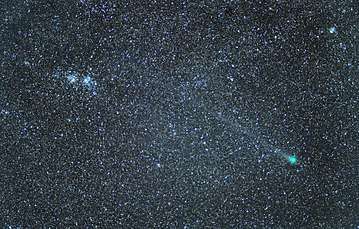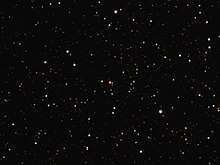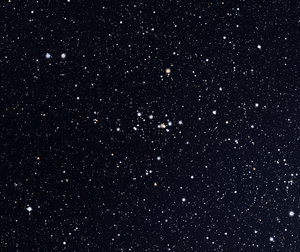DY Persei
DY Persei is a variable star and carbon star in the Perseus constellation. At maximum it is 11th magnitude carbon star and at its faintest it drops to 16th magnitude. DY Persei the prototype of the very rare DY Persei class of variables, that pulsate like red variables but also fade from sight like R Coronae Borealis variables.
| Observation data Epoch J2000.0 Equinox J2000.0 | |
|---|---|
| Constellation | Perseus |
| Right ascension | 02h 35m 17.132s[1] |
| Declination | +56° 08′ 44.68″[1] |
| Apparent magnitude (V) | 10.5 - 16.0[2] |
| Characteristics | |
| Spectral type | C5,4pJ:[3] C-R4+ C25.5[4] |
| B−V color index | 1.79[1] |
| V−R color index | 1.12[1] |
| J−H color index | 0.185[5] |
| J−K color index | 1.963[5] |
| Variable type | DY Per[6] |
| Astrometry | |
| Radial velocity (Rv) | -38[7] km/s |
| Distance | 1,500[8] pc |
| Absolute magnitude (MV) | −2.5 (max)[6] |
| Details | |
| Surface gravity (log g) | 0.0[9] cgs |
| Temperature | 2,900-3,100[9] K |
| Metallicity [Fe/H] | −2.0 to −0.5[9] dex |
| Other designations | |
| Database references | |
| SIMBAD | data |
Location
DY Persei is located on the outskirts of the Trumpler 2 open cluster, near the famous Double Cluster. At 1,500 pc, DY Persei is thought to be much further away than Trumpler 2 and not a member.
Variability

DY Persei was reported to be variable in 1947.[10] It was initially classified as a semiregular variable star with a brightness range of magnitude 10.6 to 13.2 and an approximate period of 900 days.[11] Further study revealed that it showed deep declines every few years as well as continuous variations with a rough period of 792 days. The deep declines were considered to be related to the declines seem in R CrB stars, but DY Persei was a unique example being a cool Carbon star and showing large amplitude semiregular variations when not in decline.[12]
DY Persei is now classed as a member of the very rare class of DY Persei variables, with only four known in the Milky Way and 13 more in the Magellanic Clouds.[13] It is shown declines as deep as visual magnitude 16.0.[8]
The deep declines of DY Persei occur much more regularly than those of most R CrB stars, and they are generally symmetrical with slower decline and recovery rates than other R CrB stars. It is unclear whether it is really a member of the class or a pulsating asymptotic giant branch star with unrelated veiling ejections.[6]
Companion
There is a 14th magnitude star 2.5" from DY Persei, but it appears to be a chance alignment. It was not generally recognised until 2005, and would have strongly affected observations when DY Per was below maximum light. The companion is likely to be a G5 main sequence star much further away than DY Per.[8] It had been reported that the colour of DY Persei became more blue during a deep decline, highly unexpected for a star of this type, but this has been explained as the relatively increased contribution to the light from the companion as DY Persei itself becomes fainter.[6]
Spectrum

(Juan lacruz)
DY Persei is a carbon star, with an excess of carbon relative to oxygen in its atmosphere. This causes dramatic changes in the atmospheric chemistry that are visible in the spectrum.
The spectral type under the original M-K carbon star system is C5,4pJ: (C54pJ:). This means that the spectrum overall is comparable to a late K or early M class, with strong C2 Swan bands. The "p" indicates that there are peculiarities and the "J" that there are isotopic bands from 13C. In the revised M-K system, the spectral type is C-R4+ C25.5. This describes essentially the same spectral features, although the C-R type indicates that the isotopic bands are strong but not sufficiently so to merit a "J". The exact 13C/12C ratio for DY Persei is disputed. S-process metal spectral lines are weak compared to other carbon stars, suggesting that DY Persei is not a thermally-pulsing asymptotic giant branch star. Overall, hydrogen spectral features are weak and metal lines typical, showing that DY Persei is hydrogen-deficient but not metal-poor.[8]
During deep minima, the carbon-related spectral bands become less prominent, and some emission lines are seen. In typical R CrB variables, the spectra at minimum show many strong emission lines of metals, but in DY Persei only a few are detected. A broad emission line of neutral sodium is seen, together with possible emission from neutral calcium and carbon.[8]
Properties

DY Persei has a temperature around 3,000 K, but at a deep minimum its spectrum has been best modelled as the sum of two black body objects, one of 1,700 K typical of dusty circumstellar material and one of 2,400 K typical of the coolest giant stars.[6]
The size and luminosity of DY Persei, and other DY Persei and R Coronae Borealis stars, are very poorly known.[8] The absolute magnitude is thought to be around −2.5, about 855 times brighter than the sun.[6]
The metallicity of DY Persei has been reported to be much lower than solar, but other studies consider it to be near-solar.[9][6]
References
- Høg, E.; Fabricius, C.; Makarov, V. V.; Urban, S.; Corbin, T.; Wycoff, G.; Bastian, U.; Schwekendiek, P.; Wicenec, A. (2000). "The Tycho-2 catalogue of the 2.5 million brightest stars". Astronomy and Astrophysics. 355: L27. Bibcode:2000A&A...355L..27H. doi:10.1888/0333750888/2862. ISBN 0333750888.
- Watson, C. L. (2006). "The International Variable Star Index (VSX)". The Society for Astronomical Sciences 25th Annual Symposium on Telescope Science. Held May 23–25. 25: 47. Bibcode:2006SASS...25...47W.
- Dean, C. A. (1976). "Kinematic properties of the carbon stars". The Astronomical Journal. 81: 364. Bibcode:1976AJ.....81..364D. doi:10.1086/111895.
- Keenan, Philip C. (1993). "Revised MK spectral classification of the red carbon stars". Astronomical Society of the Pacific. 105: 905. Bibcode:1993PASP..105..905K. doi:10.1086/133252.
- Cutri, R. M.; Skrutskie, M. F.; Van Dyk, S.; Beichman, C. A.; Carpenter, J. M.; Chester, T.; Cambresy, L.; Evans, T.; Fowler, J.; et al. (2003). "VizieR Online Data Catalog: 2MASS All-Sky Catalog of Point Sources (Cutri+ 2003)". VizieR On-line Data Catalog: II/246. Originally Published in: 2003yCat.2246....0C. 2246: 0. Bibcode:2003yCat.2246....0C.
- Alksnis, A.; Larionov, V. M.; Smirnova, O.; Arkharov, A. A.; Konstantinova, T. S.; Larionova, L. V.; Shenavrin, V. I. (2009). "On the Latest Deep Light Decline Event of DY Persei". Baltic Astronomy. 18: 53. Bibcode:2009BaltA..18...53A.
- Demers, S.; Battinelli, P. (2007). "C stars as kinematic probes of the Milky Way disk from 9 to 15 kpc". Astronomy and Astrophysics. 473: 143. Bibcode:2007A&A...473..143D. doi:10.1051/0004-6361:20077691.
- Začs, L.; Mondal, S.; Chen, W. P.; Pugach, A. F.; Musaev, F. A.; Alksnis, O. (2007). "A comprehensive analysis of the cool RCB star DY Persei". Astronomy and Astrophysics. 472: 247. Bibcode:2007A&A...472..247Z. doi:10.1051/0004-6361:20066923.
- Yakovina, L. A.; Pugach, A. F.; Pavlenko, Ya. V. (2009). "DY Persei, the coolest metal-poor R CrB carbon star". Astronomy Reports. 53 (3): 187. Bibcode:2009ARep...53..187Y. doi:10.1134/S1063772909030019.
- Ahnert, P.; Hoffmeister, C.; Rohlfs, E.; Van De Voorde, A. (1947). "Die veraenderlichen Sterne der nordlichen Milchstrasse. Teil IV". Veroeff. Sternwarte Sonneberg. 1: 43. Bibcode:1947VeSon...1...43A.
- Samus, N. N.; Durlevich, O. V.; et al. (2009). "VizieR Online Data Catalog: General Catalogue of Variable Stars (Samus+ 2007-2013)". VizieR On-line Data Catalog: B/gcvs. Originally Published in: 2009yCat....102025S. 1. Bibcode:2009yCat....102025S.
- Alksnis, A. (1994). "Dy-Persei - a Carbon Star of the R-Coronae Type". Baltic Astronomy. 3: 410. Bibcode:1994BaltA...3..410A. doi:10.1515/astro-1994-0406.
- Tisserand, P.; Clayton, G. C.; Welch, D. L.; Pilecki, B.; Wyrzykowski, L.; Kilkenny, D. (2013). "The ongoing pursuit of R Coronae Borealis stars: The ASAS-3 survey strikes again". Astronomy & Astrophysics. 551: A77. arXiv:1211.2475. Bibcode:2013A&A...551A..77T. doi:10.1051/0004-6361/201220713.
Further reading
- Mattei, Janet A.; Waagen, Elizabeth O.; Foster, E. Grant (1991). "R Coronae Borealis light curves 1843-1990". AAVSO Monograph. Bibcode:1991rcbl.book.....M.
